Assessment Workbook X: Financial and Business Performance Information
VerifiedAdded on 2020/04/21
|43
|8398
|34
Homework Assignment
AI Summary
This document is a comprehensive assessment workbook for the FNSACC501 unit, focusing on providing financial and business performance information. The workbook is divided into several sections, including written questions, exercises, and a case study. The written questions cover foundational knowledge of financial services legislation, Australian Accounting Standards, operating cycles, team collaboration, interpersonal skills, and budget communication. Exercises involve calculations and monitoring of financial data, while the case study requires the preparation of financial advice and evaluation of business options. The assessment evaluates the student's ability to prepare, document, and manage budgets and forecasts, as well as monitor budgeted outcomes. The workbook includes solutions to various financial calculations, such as estimating sales figures, calculating asset values, and completing a production report. The assessment emphasizes competency-based evaluation, requiring students to demonstrate their ability to perform tasks to workplace standards. The document serves as a valuable resource for students seeking to understand and excel in the FNSACC501 unit, offering detailed solutions and insights into financial and business performance concepts.
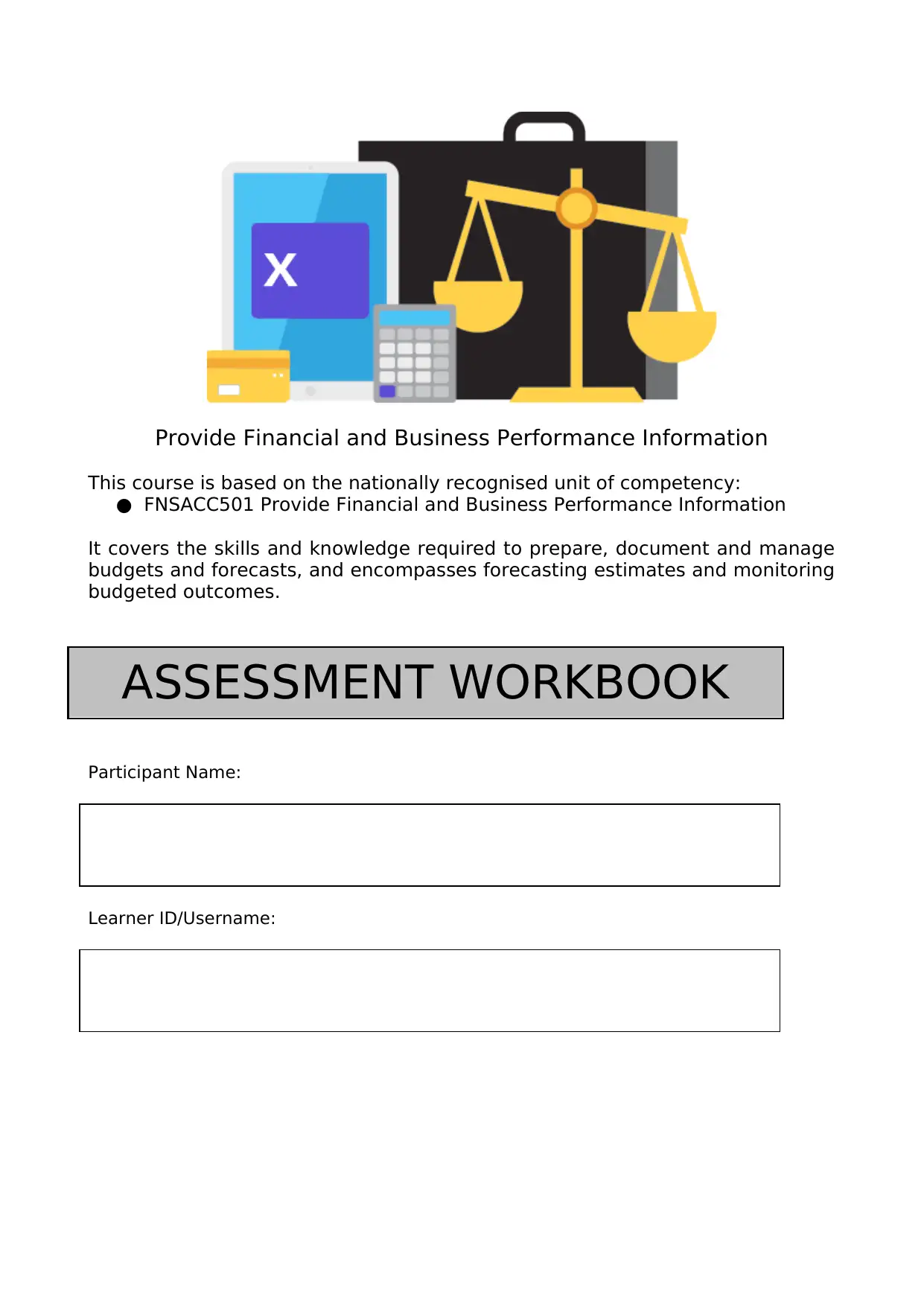
Provide Financial and Business Performance Information
This course is based on the nationally recognised unit of competency:
● FNSACC501 Provide Financial and Business Performance Information
It covers the skills and knowledge required to prepare, document and manage
budgets and forecasts, and encompasses forecasting estimates and monitoring
budgeted outcomes.
ASSESSMENT WORKBOOK
Participant Name:
Learner ID/Username:
This course is based on the nationally recognised unit of competency:
● FNSACC501 Provide Financial and Business Performance Information
It covers the skills and knowledge required to prepare, document and manage
budgets and forecasts, and encompasses forecasting estimates and monitoring
budgeted outcomes.
ASSESSMENT WORKBOOK
Participant Name:
Learner ID/Username:
Paraphrase This Document
Need a fresh take? Get an instant paraphrase of this document with our AI Paraphraser
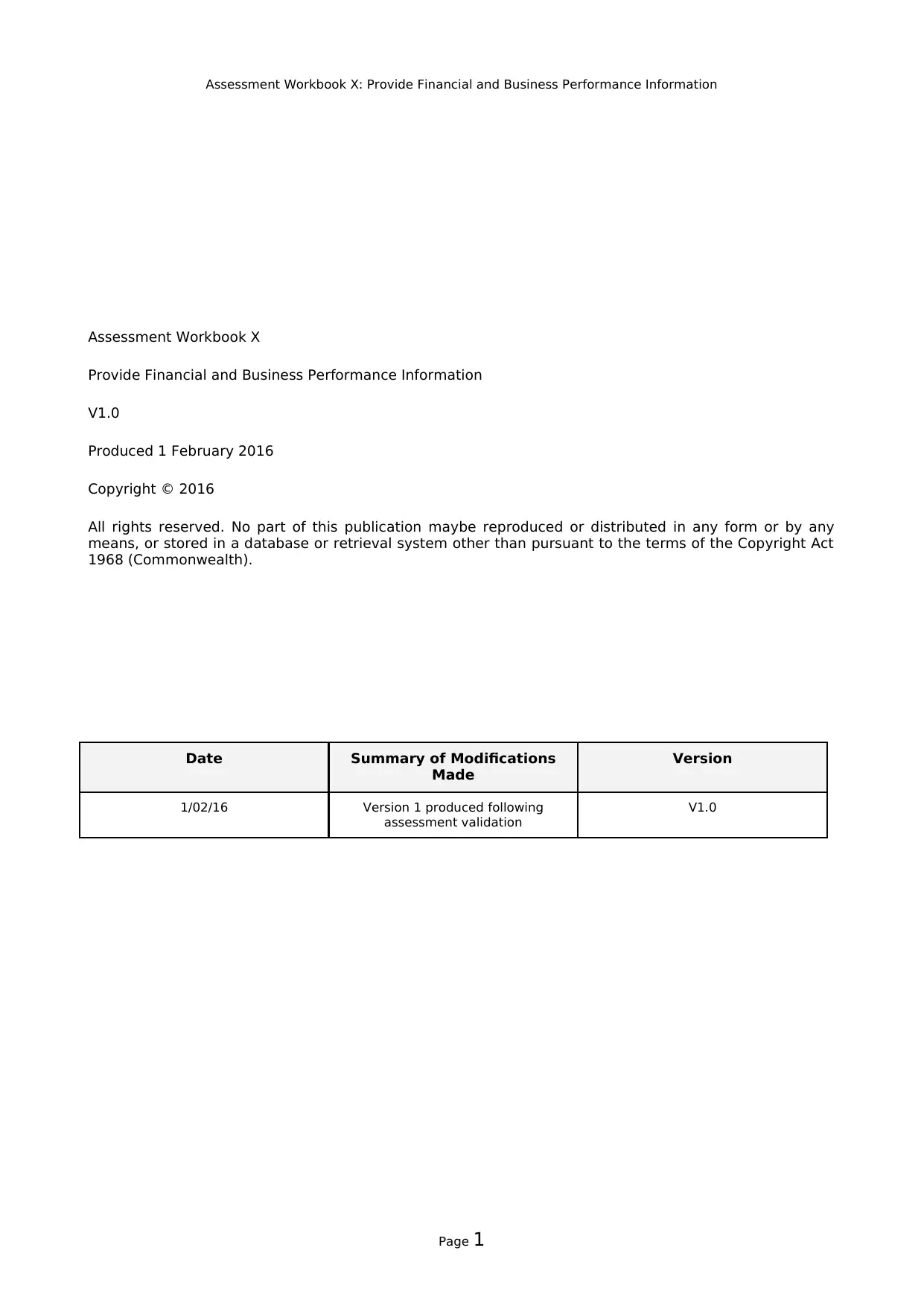
Assessment Workbook X: Provide Financial and Business Performance Information
Assessment Workbook X
Provide Financial and Business Performance Information
V1.0
Produced 1 February 2016
Copyright © 2016
All rights reserved. No part of this publication maybe reproduced or distributed in any form or by any
means, or stored in a database or retrieval system other than pursuant to the terms of the Copyright Act
1968 (Commonwealth).
Date Summary of Modifications
Made
Version
1/02/16 Version 1 produced following
assessment validation
V1.0
Page 1
Assessment Workbook X
Provide Financial and Business Performance Information
V1.0
Produced 1 February 2016
Copyright © 2016
All rights reserved. No part of this publication maybe reproduced or distributed in any form or by any
means, or stored in a database or retrieval system other than pursuant to the terms of the Copyright Act
1968 (Commonwealth).
Date Summary of Modifications
Made
Version
1/02/16 Version 1 produced following
assessment validation
V1.0
Page 1
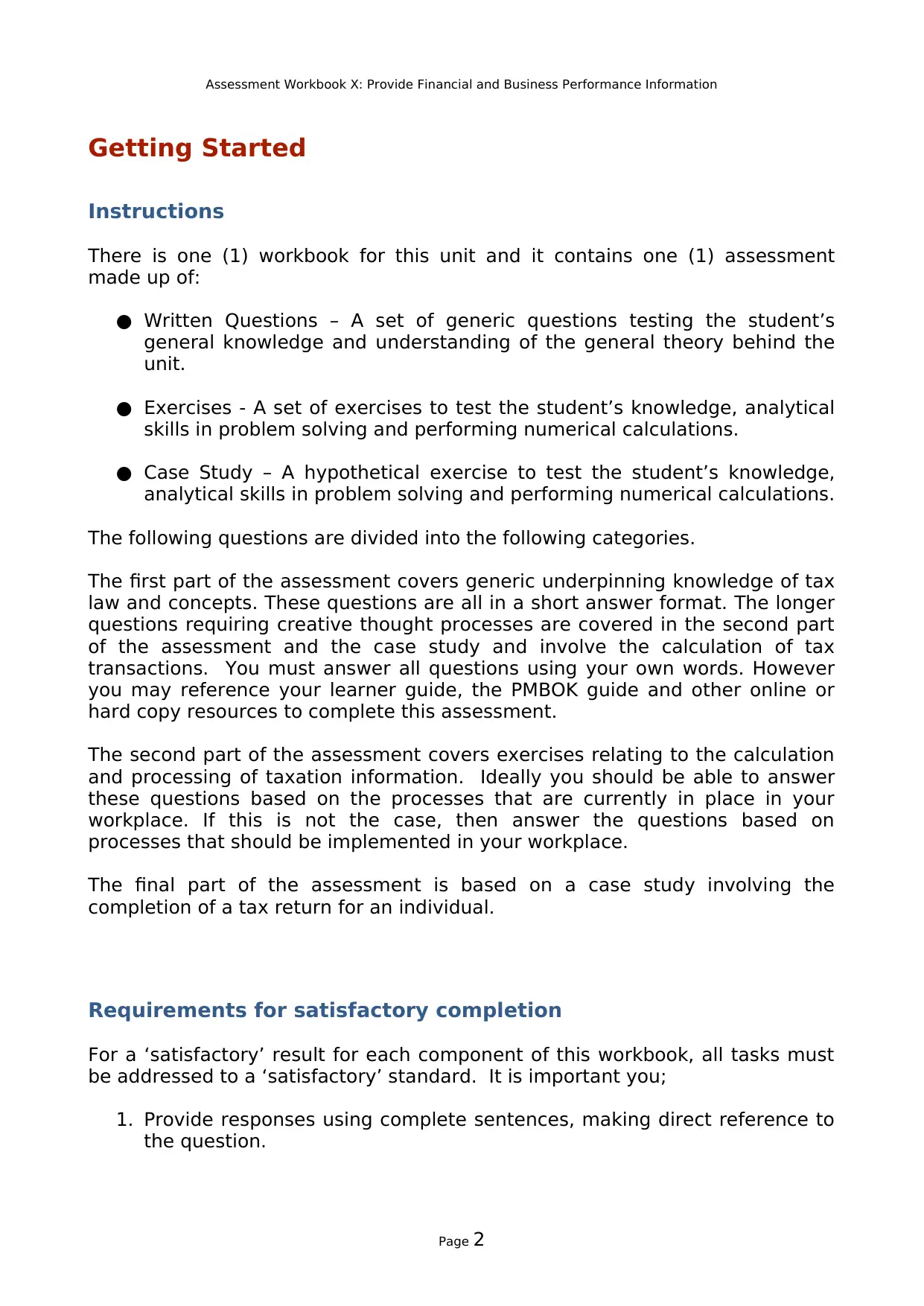
Assessment Workbook X: Provide Financial and Business Performance Information
Getting Started
Instructions
There is one (1) workbook for this unit and it contains one (1) assessment
made up of:
● Written Questions – A set of generic questions testing the student’s
general knowledge and understanding of the general theory behind the
unit.
● Exercises - A set of exercises to test the student’s knowledge, analytical
skills in problem solving and performing numerical calculations.
● Case Study – A hypothetical exercise to test the student’s knowledge,
analytical skills in problem solving and performing numerical calculations.
The following questions are divided into the following categories.
The first part of the assessment covers generic underpinning knowledge of tax
law and concepts. These questions are all in a short answer format. The longer
questions requiring creative thought processes are covered in the second part
of the assessment and the case study and involve the calculation of tax
transactions. You must answer all questions using your own words. However
you may reference your learner guide, the PMBOK guide and other online or
hard copy resources to complete this assessment.
The second part of the assessment covers exercises relating to the calculation
and processing of taxation information. Ideally you should be able to answer
these questions based on the processes that are currently in place in your
workplace. If this is not the case, then answer the questions based on
processes that should be implemented in your workplace.
The final part of the assessment is based on a case study involving the
completion of a tax return for an individual.
Requirements for satisfactory completion
For a ‘satisfactory’ result for each component of this workbook, all tasks must
be addressed to a ‘satisfactory’ standard. It is important you;
1. Provide responses using complete sentences, making direct reference to
the question.
Page 2
Getting Started
Instructions
There is one (1) workbook for this unit and it contains one (1) assessment
made up of:
● Written Questions – A set of generic questions testing the student’s
general knowledge and understanding of the general theory behind the
unit.
● Exercises - A set of exercises to test the student’s knowledge, analytical
skills in problem solving and performing numerical calculations.
● Case Study – A hypothetical exercise to test the student’s knowledge,
analytical skills in problem solving and performing numerical calculations.
The following questions are divided into the following categories.
The first part of the assessment covers generic underpinning knowledge of tax
law and concepts. These questions are all in a short answer format. The longer
questions requiring creative thought processes are covered in the second part
of the assessment and the case study and involve the calculation of tax
transactions. You must answer all questions using your own words. However
you may reference your learner guide, the PMBOK guide and other online or
hard copy resources to complete this assessment.
The second part of the assessment covers exercises relating to the calculation
and processing of taxation information. Ideally you should be able to answer
these questions based on the processes that are currently in place in your
workplace. If this is not the case, then answer the questions based on
processes that should be implemented in your workplace.
The final part of the assessment is based on a case study involving the
completion of a tax return for an individual.
Requirements for satisfactory completion
For a ‘satisfactory’ result for each component of this workbook, all tasks must
be addressed to a ‘satisfactory’ standard. It is important you;
1. Provide responses using complete sentences, making direct reference to
the question.
Page 2
⊘ This is a preview!⊘
Do you want full access?
Subscribe today to unlock all pages.

Trusted by 1+ million students worldwide
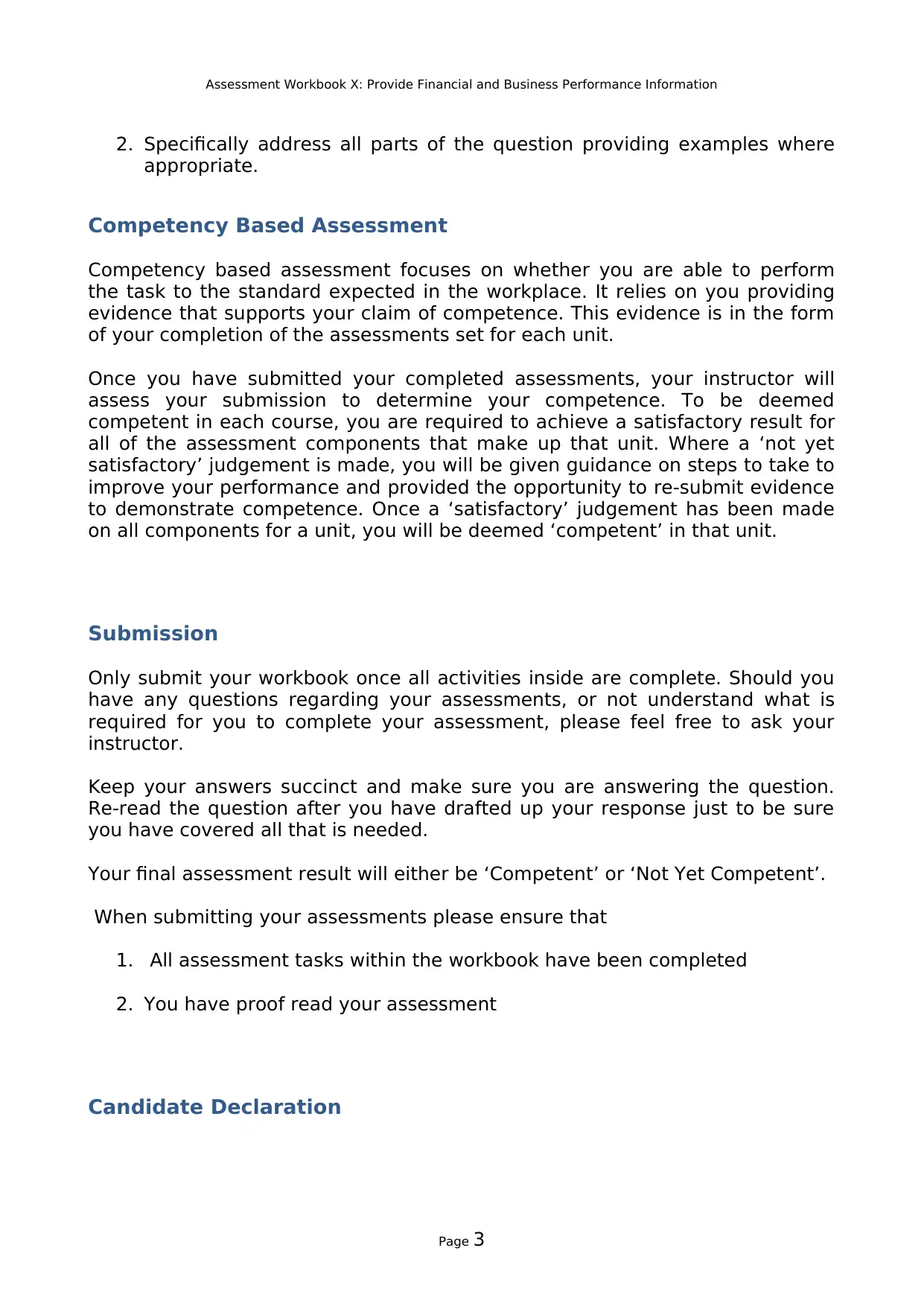
Assessment Workbook X: Provide Financial and Business Performance Information
2. Specifically address all parts of the question providing examples where
appropriate.
Competency Based Assessment
Competency based assessment focuses on whether you are able to perform
the task to the standard expected in the workplace. It relies on you providing
evidence that supports your claim of competence. This evidence is in the form
of your completion of the assessments set for each unit.
Once you have submitted your completed assessments, your instructor will
assess your submission to determine your competence. To be deemed
competent in each course, you are required to achieve a satisfactory result for
all of the assessment components that make up that unit. Where a ‘not yet
satisfactory’ judgement is made, you will be given guidance on steps to take to
improve your performance and provided the opportunity to re-submit evidence
to demonstrate competence. Once a ‘satisfactory’ judgement has been made
on all components for a unit, you will be deemed ‘competent’ in that unit.
Submission
Only submit your workbook once all activities inside are complete. Should you
have any questions regarding your assessments, or not understand what is
required for you to complete your assessment, please feel free to ask your
instructor.
Keep your answers succinct and make sure you are answering the question.
Re-read the question after you have drafted up your response just to be sure
you have covered all that is needed.
Your final assessment result will either be ‘Competent’ or ‘Not Yet Competent’.
When submitting your assessments please ensure that
1. All assessment tasks within the workbook have been completed
2. You have proof read your assessment
Candidate Declaration
Page 3
2. Specifically address all parts of the question providing examples where
appropriate.
Competency Based Assessment
Competency based assessment focuses on whether you are able to perform
the task to the standard expected in the workplace. It relies on you providing
evidence that supports your claim of competence. This evidence is in the form
of your completion of the assessments set for each unit.
Once you have submitted your completed assessments, your instructor will
assess your submission to determine your competence. To be deemed
competent in each course, you are required to achieve a satisfactory result for
all of the assessment components that make up that unit. Where a ‘not yet
satisfactory’ judgement is made, you will be given guidance on steps to take to
improve your performance and provided the opportunity to re-submit evidence
to demonstrate competence. Once a ‘satisfactory’ judgement has been made
on all components for a unit, you will be deemed ‘competent’ in that unit.
Submission
Only submit your workbook once all activities inside are complete. Should you
have any questions regarding your assessments, or not understand what is
required for you to complete your assessment, please feel free to ask your
instructor.
Keep your answers succinct and make sure you are answering the question.
Re-read the question after you have drafted up your response just to be sure
you have covered all that is needed.
Your final assessment result will either be ‘Competent’ or ‘Not Yet Competent’.
When submitting your assessments please ensure that
1. All assessment tasks within the workbook have been completed
2. You have proof read your assessment
Candidate Declaration
Page 3
Paraphrase This Document
Need a fresh take? Get an instant paraphrase of this document with our AI Paraphraser
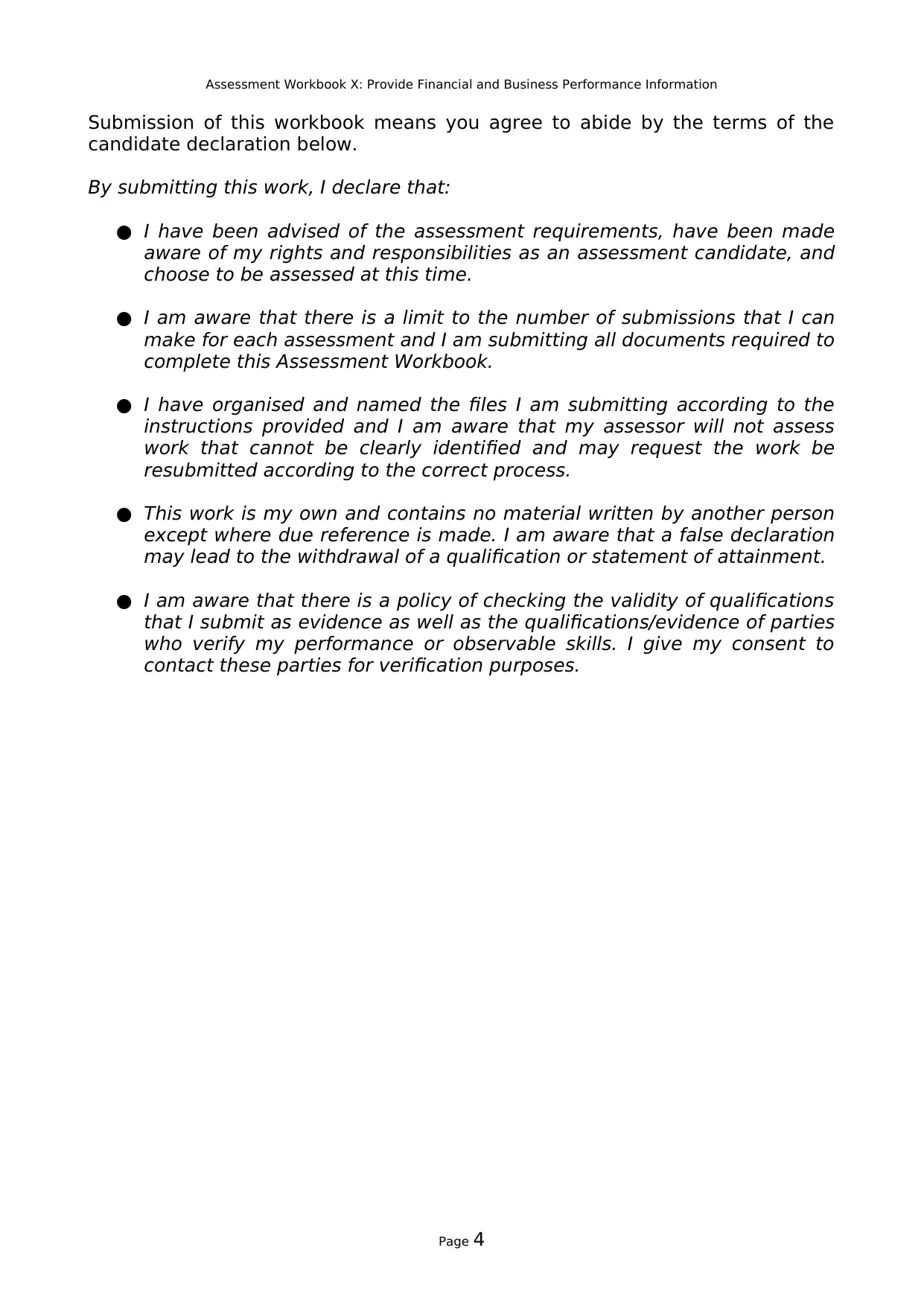
Assessment Workbook X: Provide Financial and Business Performance Information
Submission of this workbook means you agree to abide by the terms of the
candidate declaration below.
By submitting this work, I declare that:
● I have been advised of the assessment requirements, have been made
aware of my rights and responsibilities as an assessment candidate, and
choose to be assessed at this time.
● I am aware that there is a limit to the number of submissions that I can
make for each assessment and I am submitting all documents required to
complete this Assessment Workbook.
● I have organised and named the files I am submitting according to the
instructions provided and I am aware that my assessor will not assess
work that cannot be clearly identified and may request the work be
resubmitted according to the correct process.
● This work is my own and contains no material written by another person
except where due reference is made. I am aware that a false declaration
may lead to the withdrawal of a qualification or statement of attainment.
● I am aware that there is a policy of checking the validity of qualifications
that I submit as evidence as well as the qualifications/evidence of parties
who verify my performance or observable skills. I give my consent to
contact these parties for verification purposes.
Page 4
Submission of this workbook means you agree to abide by the terms of the
candidate declaration below.
By submitting this work, I declare that:
● I have been advised of the assessment requirements, have been made
aware of my rights and responsibilities as an assessment candidate, and
choose to be assessed at this time.
● I am aware that there is a limit to the number of submissions that I can
make for each assessment and I am submitting all documents required to
complete this Assessment Workbook.
● I have organised and named the files I am submitting according to the
instructions provided and I am aware that my assessor will not assess
work that cannot be clearly identified and may request the work be
resubmitted according to the correct process.
● This work is my own and contains no material written by another person
except where due reference is made. I am aware that a false declaration
may lead to the withdrawal of a qualification or statement of attainment.
● I am aware that there is a policy of checking the validity of qualifications
that I submit as evidence as well as the qualifications/evidence of parties
who verify my performance or observable skills. I give my consent to
contact these parties for verification purposes.
Page 4
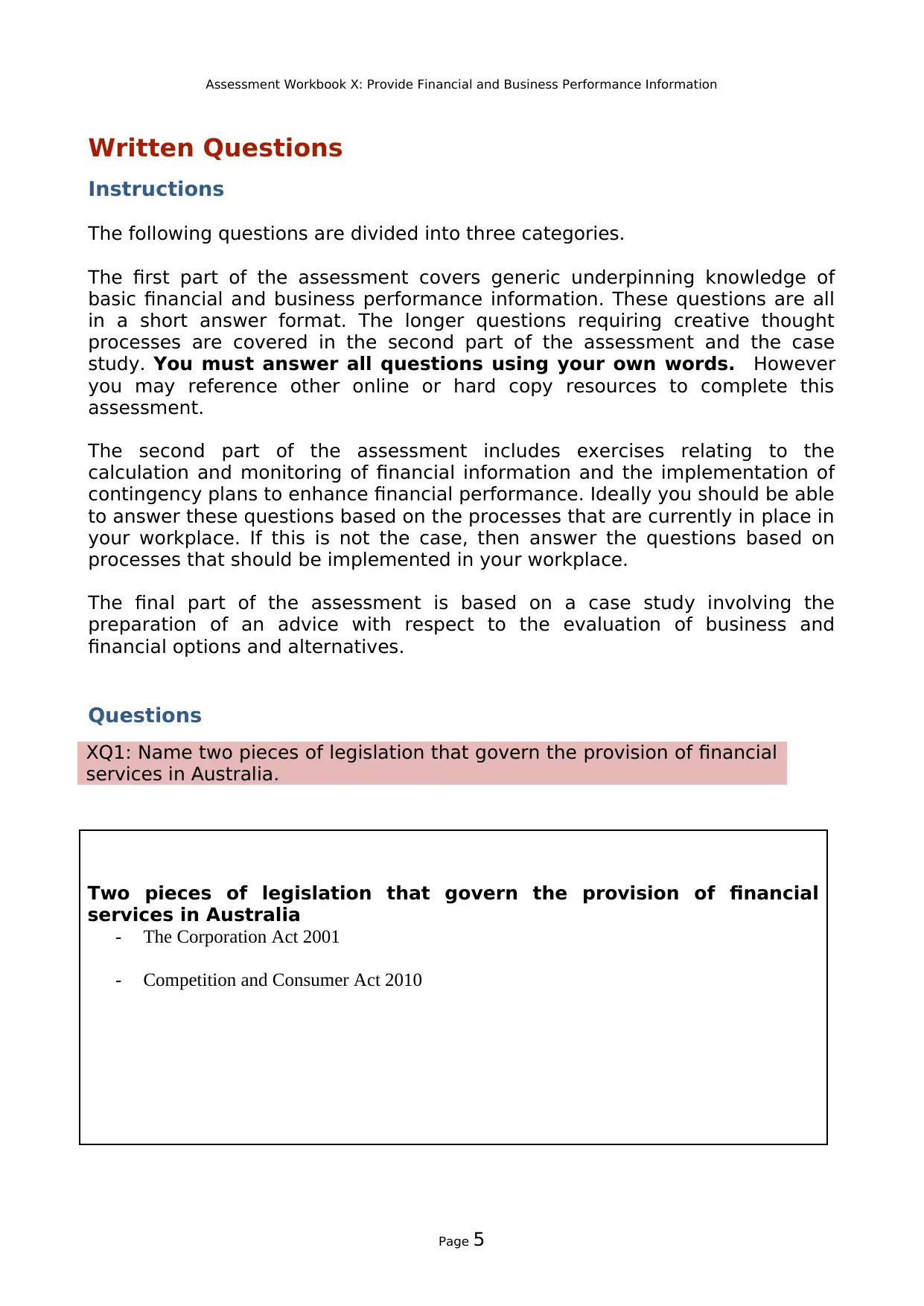
Assessment Workbook X: Provide Financial and Business Performance Information
Written Questions
Instructions
The following questions are divided into three categories.
The first part of the assessment covers generic underpinning knowledge of
basic financial and business performance information. These questions are all
in a short answer format. The longer questions requiring creative thought
processes are covered in the second part of the assessment and the case
study. You must answer all questions using your own words. However
you may reference other online or hard copy resources to complete this
assessment.
The second part of the assessment includes exercises relating to the
calculation and monitoring of financial information and the implementation of
contingency plans to enhance financial performance. Ideally you should be able
to answer these questions based on the processes that are currently in place in
your workplace. If this is not the case, then answer the questions based on
processes that should be implemented in your workplace.
The final part of the assessment is based on a case study involving the
preparation of an advice with respect to the evaluation of business and
financial options and alternatives.
Questions
XQ1: Name two pieces of legislation that govern the provision of financial
services in Australia.
Two pieces of legislation that govern the provision of financial
services in Australia
- The Corporation Act 2001
- Competition and Consumer Act 2010
Page 5
Written Questions
Instructions
The following questions are divided into three categories.
The first part of the assessment covers generic underpinning knowledge of
basic financial and business performance information. These questions are all
in a short answer format. The longer questions requiring creative thought
processes are covered in the second part of the assessment and the case
study. You must answer all questions using your own words. However
you may reference other online or hard copy resources to complete this
assessment.
The second part of the assessment includes exercises relating to the
calculation and monitoring of financial information and the implementation of
contingency plans to enhance financial performance. Ideally you should be able
to answer these questions based on the processes that are currently in place in
your workplace. If this is not the case, then answer the questions based on
processes that should be implemented in your workplace.
The final part of the assessment is based on a case study involving the
preparation of an advice with respect to the evaluation of business and
financial options and alternatives.
Questions
XQ1: Name two pieces of legislation that govern the provision of financial
services in Australia.
Two pieces of legislation that govern the provision of financial
services in Australia
- The Corporation Act 2001
- Competition and Consumer Act 2010
Page 5
⊘ This is a preview!⊘
Do you want full access?
Subscribe today to unlock all pages.

Trusted by 1+ million students worldwide
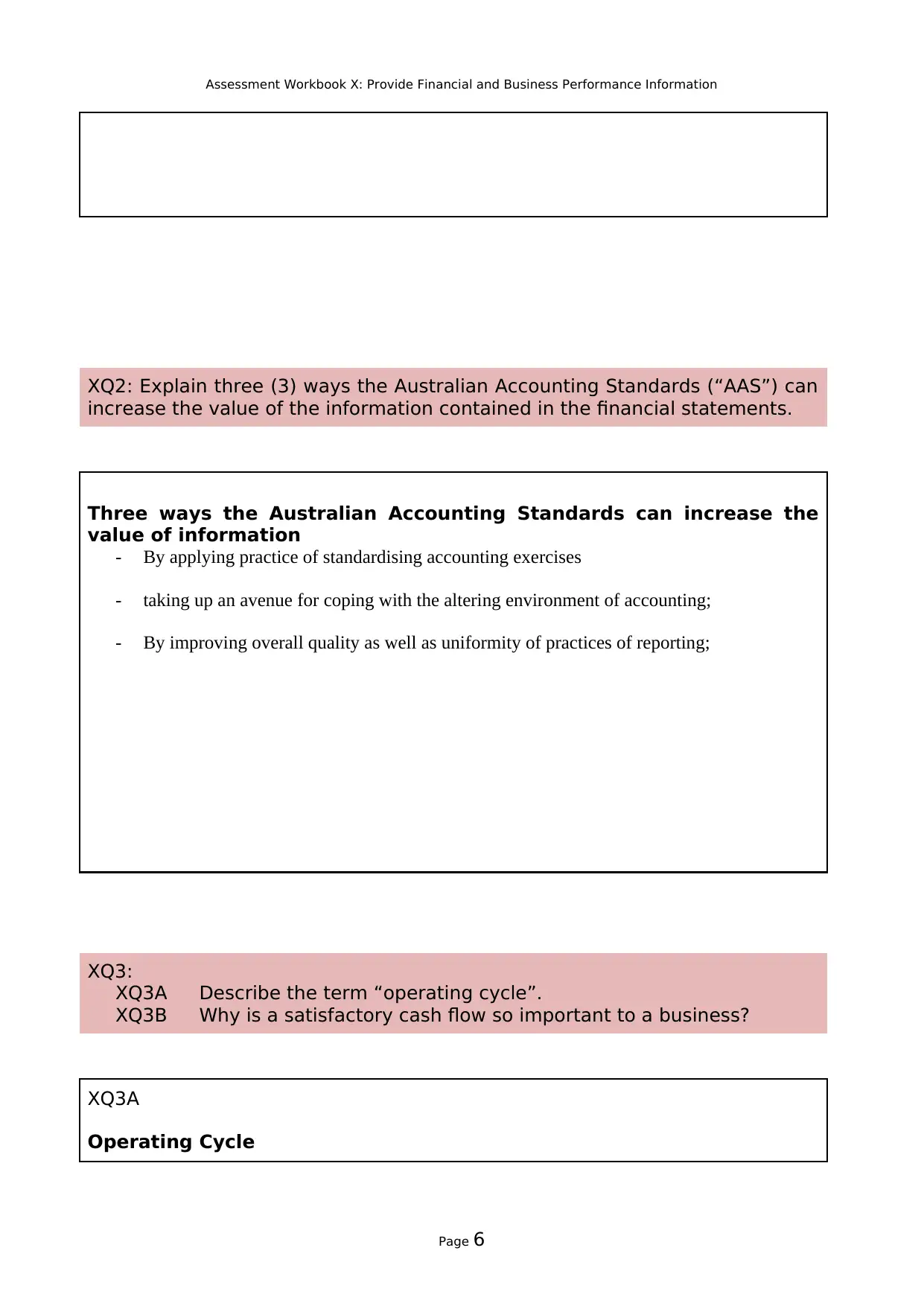
Assessment Workbook X: Provide Financial and Business Performance Information
XQ2: Explain three (3) ways the Australian Accounting Standards (“AAS”) can
increase the value of the information contained in the financial statements.
Three ways the Australian Accounting Standards can increase the
value of information
- By applying practice of standardising accounting exercises
- taking up an avenue for coping with the altering environment of accounting;
- By improving overall quality as well as uniformity of practices of reporting;
XQ3:
XQ3A Describe the term “operating cycle”.
XQ3B Why is a satisfactory cash flow so important to a business?
XQ3A
Operating Cycle
Page 6
XQ2: Explain three (3) ways the Australian Accounting Standards (“AAS”) can
increase the value of the information contained in the financial statements.
Three ways the Australian Accounting Standards can increase the
value of information
- By applying practice of standardising accounting exercises
- taking up an avenue for coping with the altering environment of accounting;
- By improving overall quality as well as uniformity of practices of reporting;
XQ3:
XQ3A Describe the term “operating cycle”.
XQ3B Why is a satisfactory cash flow so important to a business?
XQ3A
Operating Cycle
Page 6
Paraphrase This Document
Need a fresh take? Get an instant paraphrase of this document with our AI Paraphraser
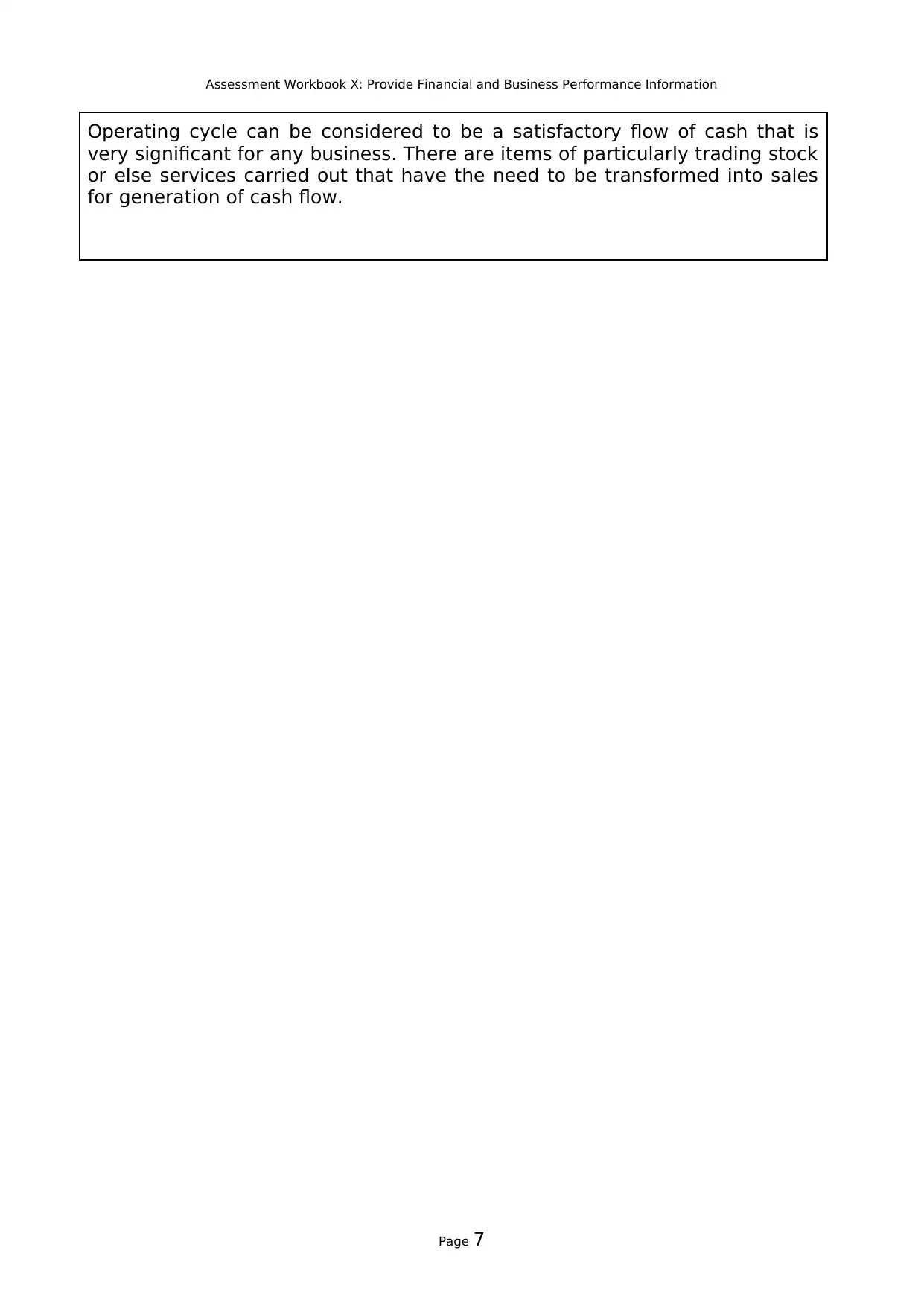
Assessment Workbook X: Provide Financial and Business Performance Information
Operating cycle can be considered to be a satisfactory flow of cash that is
very significant for any business. There are items of particularly trading stock
or else services carried out that have the need to be transformed into sales
for generation of cash flow.
Page 7
Operating cycle can be considered to be a satisfactory flow of cash that is
very significant for any business. There are items of particularly trading stock
or else services carried out that have the need to be transformed into sales
for generation of cash flow.
Page 7
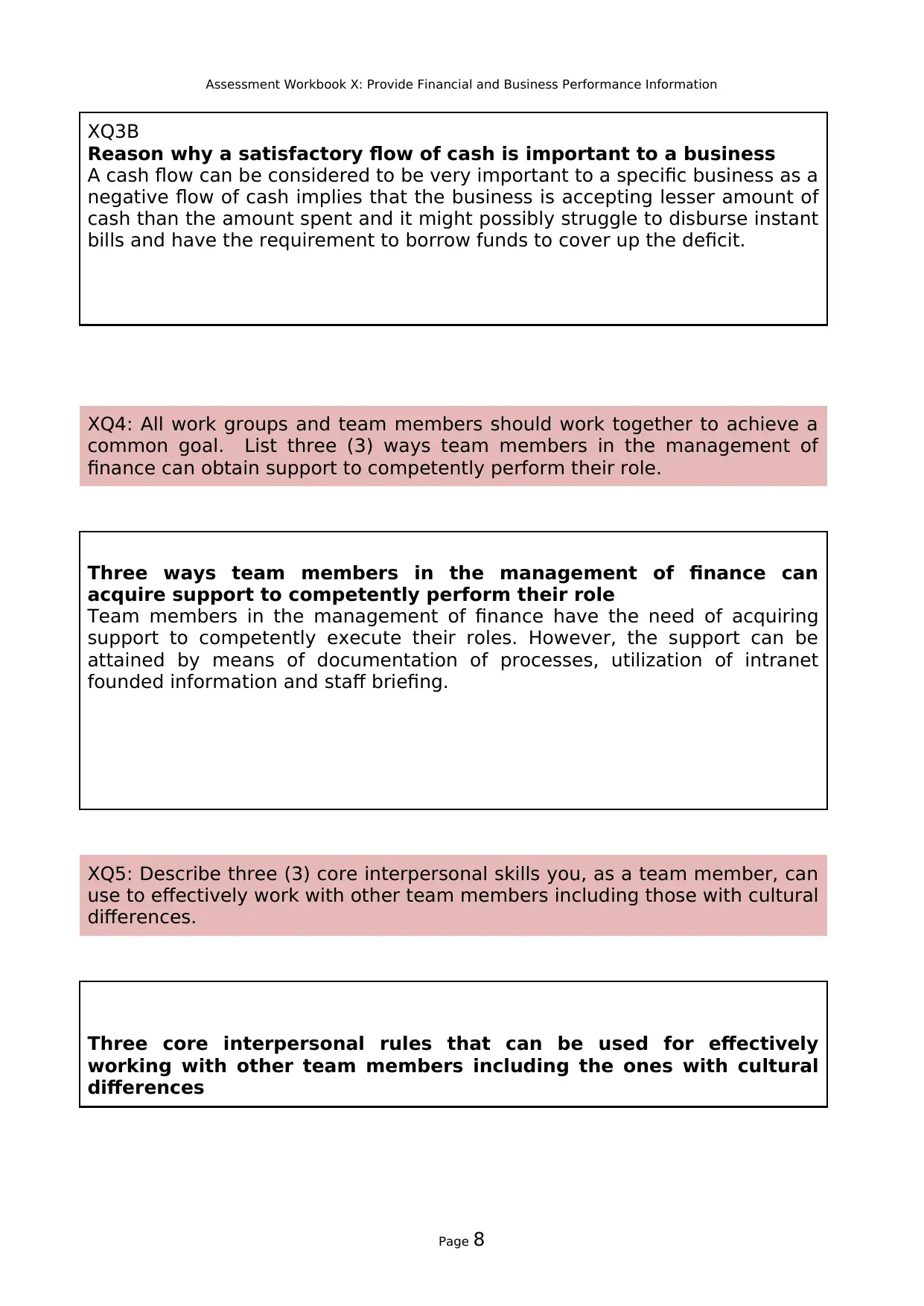
Assessment Workbook X: Provide Financial and Business Performance Information
XQ3B
Reason why a satisfactory flow of cash is important to a business
A cash flow can be considered to be very important to a specific business as a
negative flow of cash implies that the business is accepting lesser amount of
cash than the amount spent and it might possibly struggle to disburse instant
bills and have the requirement to borrow funds to cover up the deficit.
XQ4: All work groups and team members should work together to achieve a
common goal. List three (3) ways team members in the management of
finance can obtain support to competently perform their role.
Three ways team members in the management of finance can
acquire support to competently perform their role
Team members in the management of finance have the need of acquiring
support to competently execute their roles. However, the support can be
attained by means of documentation of processes, utilization of intranet
founded information and staff briefing.
XQ5: Describe three (3) core interpersonal skills you, as a team member, can
use to effectively work with other team members including those with cultural
differences.
Three core interpersonal rules that can be used for effectively
working with other team members including the ones with cultural
differences
Page 8
XQ3B
Reason why a satisfactory flow of cash is important to a business
A cash flow can be considered to be very important to a specific business as a
negative flow of cash implies that the business is accepting lesser amount of
cash than the amount spent and it might possibly struggle to disburse instant
bills and have the requirement to borrow funds to cover up the deficit.
XQ4: All work groups and team members should work together to achieve a
common goal. List three (3) ways team members in the management of
finance can obtain support to competently perform their role.
Three ways team members in the management of finance can
acquire support to competently perform their role
Team members in the management of finance have the need of acquiring
support to competently execute their roles. However, the support can be
attained by means of documentation of processes, utilization of intranet
founded information and staff briefing.
XQ5: Describe three (3) core interpersonal skills you, as a team member, can
use to effectively work with other team members including those with cultural
differences.
Three core interpersonal rules that can be used for effectively
working with other team members including the ones with cultural
differences
Page 8
⊘ This is a preview!⊘
Do you want full access?
Subscribe today to unlock all pages.

Trusted by 1+ million students worldwide
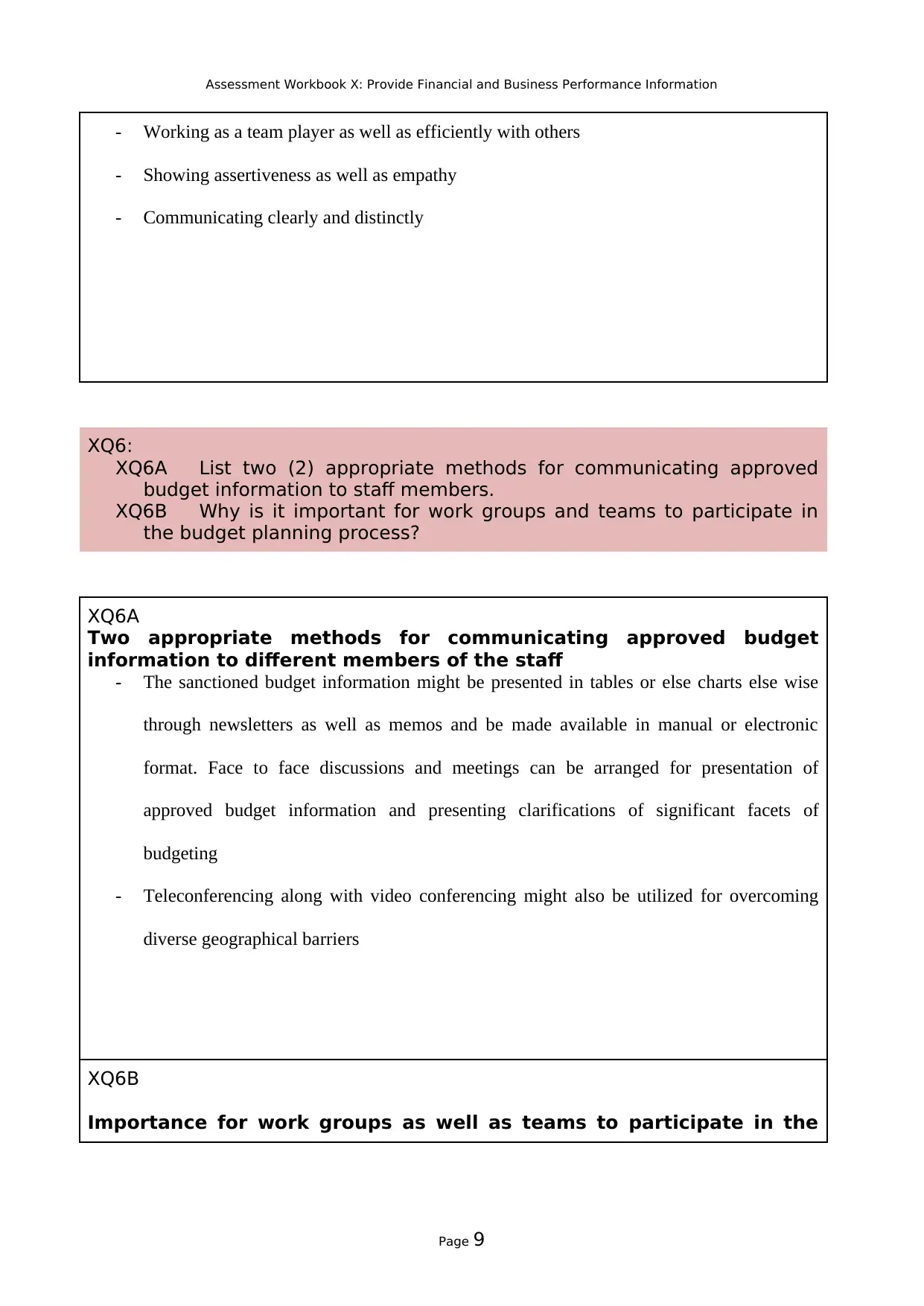
Assessment Workbook X: Provide Financial and Business Performance Information
- Working as a team player as well as efficiently with others
- Showing assertiveness as well as empathy
- Communicating clearly and distinctly
XQ6:
XQ6A List two (2) appropriate methods for communicating approved
budget information to staff members.
XQ6B Why is it important for work groups and teams to participate in
the budget planning process?
XQ6A
Two appropriate methods for communicating approved budget
information to different members of the staff
- The sanctioned budget information might be presented in tables or else charts else wise
through newsletters as well as memos and be made available in manual or electronic
format. Face to face discussions and meetings can be arranged for presentation of
approved budget information and presenting clarifications of significant facets of
budgeting
- Teleconferencing along with video conferencing might also be utilized for overcoming
diverse geographical barriers
XQ6B
Importance for work groups as well as teams to participate in the
Page 9
- Working as a team player as well as efficiently with others
- Showing assertiveness as well as empathy
- Communicating clearly and distinctly
XQ6:
XQ6A List two (2) appropriate methods for communicating approved
budget information to staff members.
XQ6B Why is it important for work groups and teams to participate in
the budget planning process?
XQ6A
Two appropriate methods for communicating approved budget
information to different members of the staff
- The sanctioned budget information might be presented in tables or else charts else wise
through newsletters as well as memos and be made available in manual or electronic
format. Face to face discussions and meetings can be arranged for presentation of
approved budget information and presenting clarifications of significant facets of
budgeting
- Teleconferencing along with video conferencing might also be utilized for overcoming
diverse geographical barriers
XQ6B
Importance for work groups as well as teams to participate in the
Page 9
Paraphrase This Document
Need a fresh take? Get an instant paraphrase of this document with our AI Paraphraser
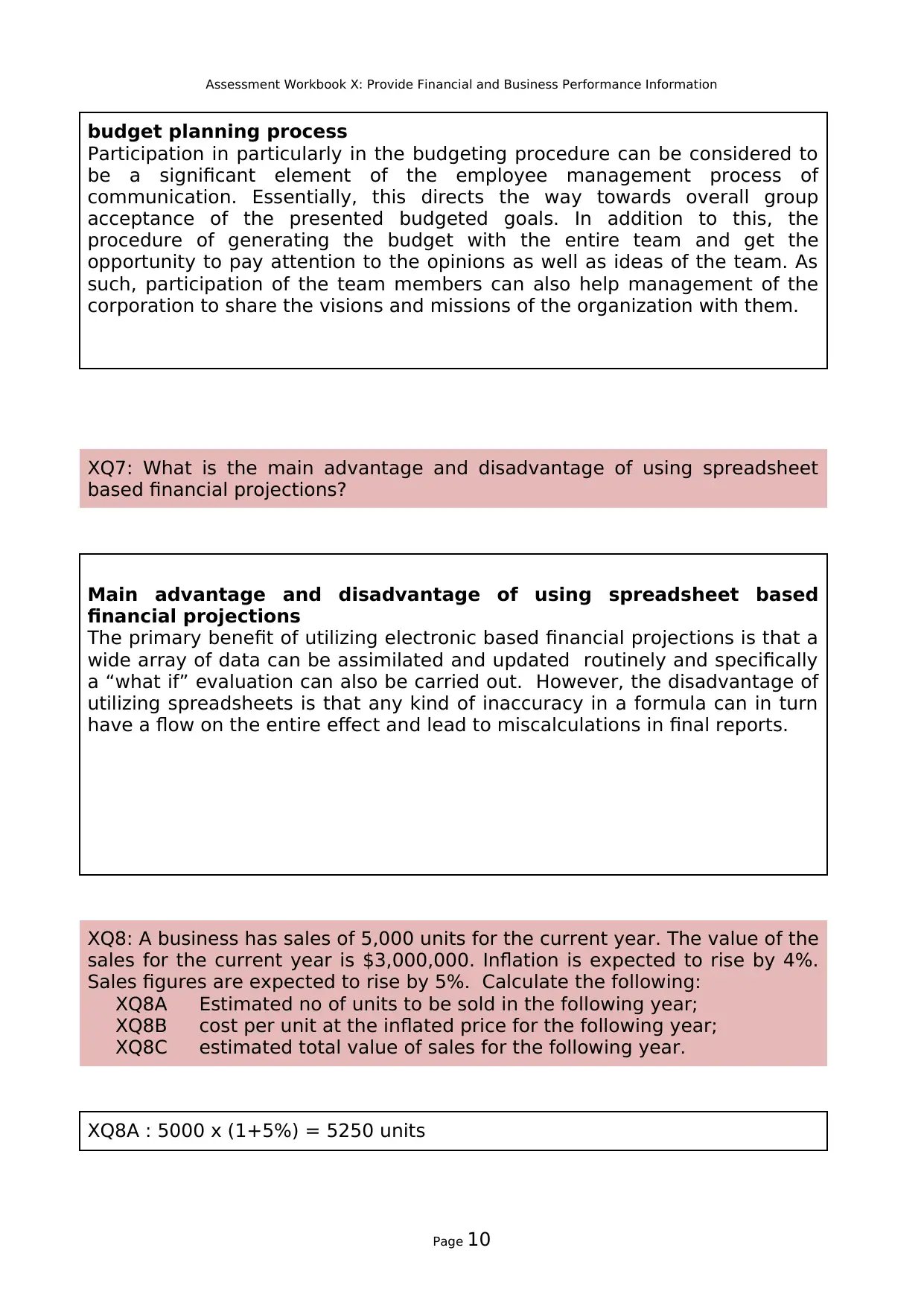
Assessment Workbook X: Provide Financial and Business Performance Information
budget planning process
Participation in particularly in the budgeting procedure can be considered to
be a significant element of the employee management process of
communication. Essentially, this directs the way towards overall group
acceptance of the presented budgeted goals. In addition to this, the
procedure of generating the budget with the entire team and get the
opportunity to pay attention to the opinions as well as ideas of the team. As
such, participation of the team members can also help management of the
corporation to share the visions and missions of the organization with them.
XQ7: What is the main advantage and disadvantage of using spreadsheet
based financial projections?
Main advantage and disadvantage of using spreadsheet based
financial projections
The primary benefit of utilizing electronic based financial projections is that a
wide array of data can be assimilated and updated routinely and specifically
a “what if” evaluation can also be carried out. However, the disadvantage of
utilizing spreadsheets is that any kind of inaccuracy in a formula can in turn
have a flow on the entire effect and lead to miscalculations in final reports.
XQ8: A business has sales of 5,000 units for the current year. The value of the
sales for the current year is $3,000,000. Inflation is expected to rise by 4%.
Sales figures are expected to rise by 5%. Calculate the following:
XQ8A Estimated no of units to be sold in the following year;
XQ8B cost per unit at the inflated price for the following year;
XQ8C estimated total value of sales for the following year.
XQ8A : 5000 x (1+5%) = 5250 units
Page 10
budget planning process
Participation in particularly in the budgeting procedure can be considered to
be a significant element of the employee management process of
communication. Essentially, this directs the way towards overall group
acceptance of the presented budgeted goals. In addition to this, the
procedure of generating the budget with the entire team and get the
opportunity to pay attention to the opinions as well as ideas of the team. As
such, participation of the team members can also help management of the
corporation to share the visions and missions of the organization with them.
XQ7: What is the main advantage and disadvantage of using spreadsheet
based financial projections?
Main advantage and disadvantage of using spreadsheet based
financial projections
The primary benefit of utilizing electronic based financial projections is that a
wide array of data can be assimilated and updated routinely and specifically
a “what if” evaluation can also be carried out. However, the disadvantage of
utilizing spreadsheets is that any kind of inaccuracy in a formula can in turn
have a flow on the entire effect and lead to miscalculations in final reports.
XQ8: A business has sales of 5,000 units for the current year. The value of the
sales for the current year is $3,000,000. Inflation is expected to rise by 4%.
Sales figures are expected to rise by 5%. Calculate the following:
XQ8A Estimated no of units to be sold in the following year;
XQ8B cost per unit at the inflated price for the following year;
XQ8C estimated total value of sales for the following year.
XQ8A : 5000 x (1+5%) = 5250 units
Page 10
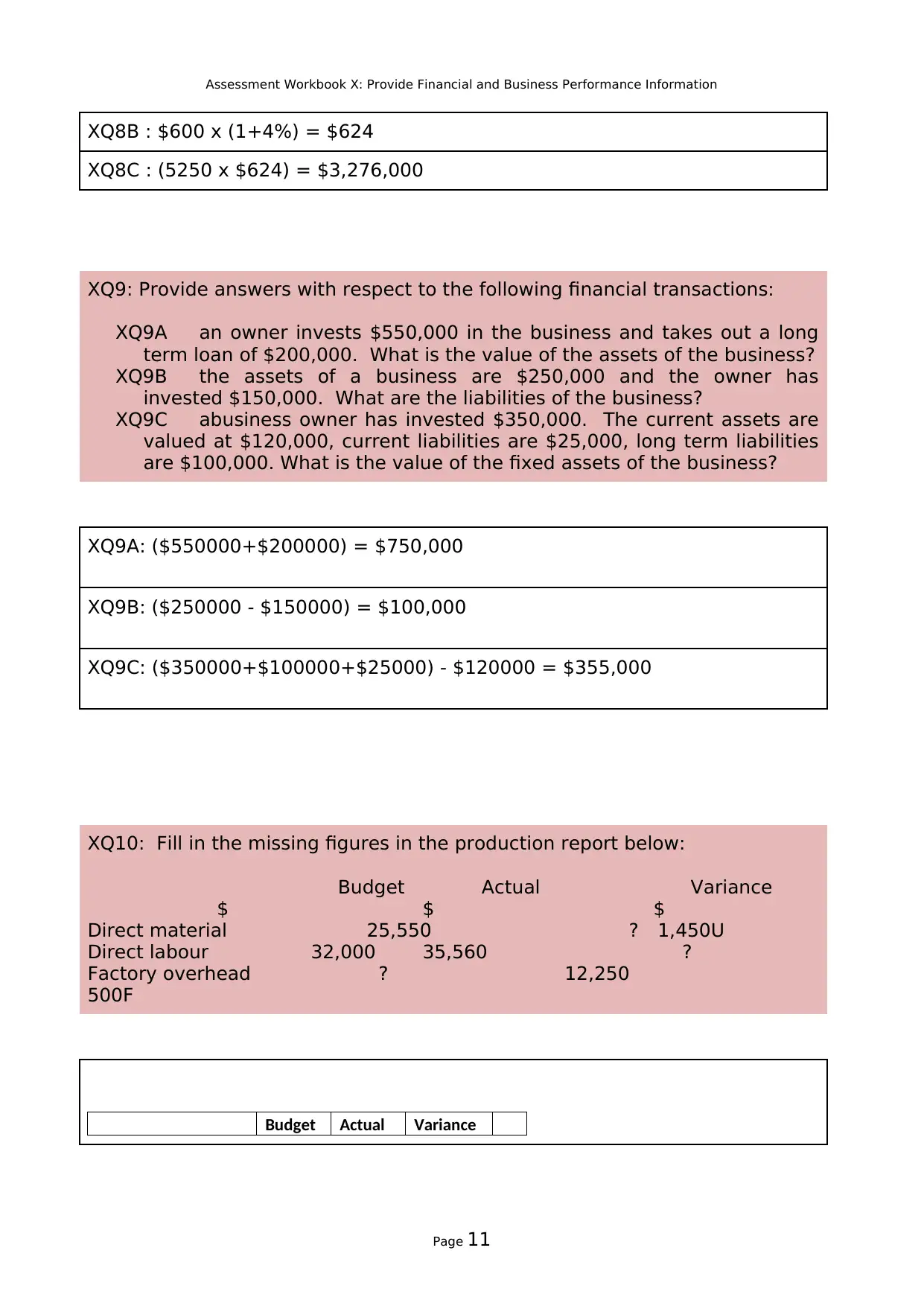
Assessment Workbook X: Provide Financial and Business Performance Information
XQ8B : $600 x (1+4%) = $624
XQ8C : (5250 x $624) = $3,276,000
XQ9: Provide answers with respect to the following financial transactions:
XQ9A an owner invests $550,000 in the business and takes out a long
term loan of $200,000. What is the value of the assets of the business?
XQ9B the assets of a business are $250,000 and the owner has
invested $150,000. What are the liabilities of the business?
XQ9C abusiness owner has invested $350,000. The current assets are
valued at $120,000, current liabilities are $25,000, long term liabilities
are $100,000. What is the value of the fixed assets of the business?
XQ9A: ($550000+$200000) = $750,000
XQ9B: ($250000 - $150000) = $100,000
XQ9C: ($350000+$100000+$25000) - $120000 = $355,000
XQ10: Fill in the missing figures in the production report below:
Budget Actual Variance
$ $ $
Direct material 25,550 ? 1,450U
Direct labour 32,000 35,560 ?
Factory overhead ? 12,250
500F
Budget Actual Variance
Page 11
XQ8B : $600 x (1+4%) = $624
XQ8C : (5250 x $624) = $3,276,000
XQ9: Provide answers with respect to the following financial transactions:
XQ9A an owner invests $550,000 in the business and takes out a long
term loan of $200,000. What is the value of the assets of the business?
XQ9B the assets of a business are $250,000 and the owner has
invested $150,000. What are the liabilities of the business?
XQ9C abusiness owner has invested $350,000. The current assets are
valued at $120,000, current liabilities are $25,000, long term liabilities
are $100,000. What is the value of the fixed assets of the business?
XQ9A: ($550000+$200000) = $750,000
XQ9B: ($250000 - $150000) = $100,000
XQ9C: ($350000+$100000+$25000) - $120000 = $355,000
XQ10: Fill in the missing figures in the production report below:
Budget Actual Variance
$ $ $
Direct material 25,550 ? 1,450U
Direct labour 32,000 35,560 ?
Factory overhead ? 12,250
500F
Budget Actual Variance
Page 11
⊘ This is a preview!⊘
Do you want full access?
Subscribe today to unlock all pages.

Trusted by 1+ million students worldwide
1 out of 43
Related Documents
Your All-in-One AI-Powered Toolkit for Academic Success.
+13062052269
info@desklib.com
Available 24*7 on WhatsApp / Email
![[object Object]](/_next/static/media/star-bottom.7253800d.svg)
Unlock your academic potential
Copyright © 2020–2025 A2Z Services. All Rights Reserved. Developed and managed by ZUCOL.





